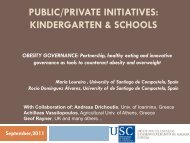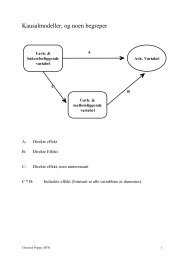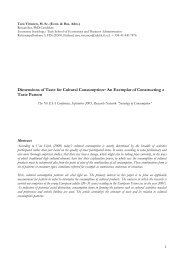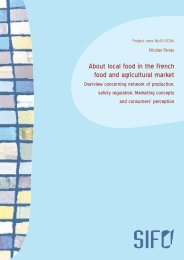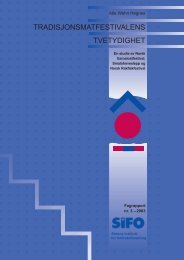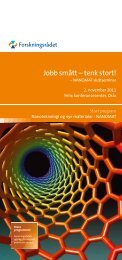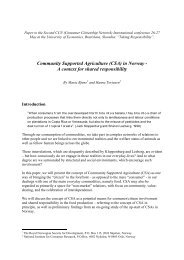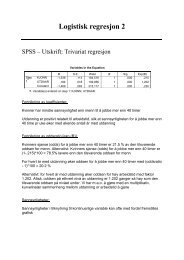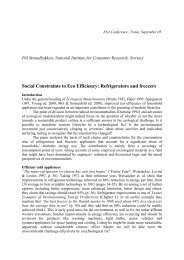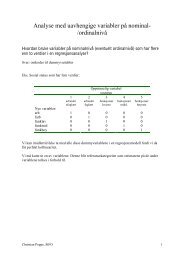an investigation of domestic laundry in europe - habits ... - SIFO
an investigation of domestic laundry in europe - habits ... - SIFO
an investigation of domestic laundry in europe - habits ... - SIFO
Create successful ePaper yourself
Turn your PDF publications into a flip-book with our unique Google optimized e-Paper software.
Hygiene effects <strong>of</strong> <strong>laundry</strong> processes <strong>in</strong> Europe 75us<strong>in</strong>g different k<strong>in</strong>ds <strong>of</strong> dis<strong>in</strong>fect<strong>an</strong>ts, Scott [4] also showed that the <strong>in</strong>itialcounts <strong>of</strong> a three-day-old used dishcloth varied from 1.7*10 2 to 2.5*10 6CFU/cm 2 . The Total Plate Count <strong>in</strong>creased after wash<strong>in</strong>g or dis<strong>in</strong>fect<strong>in</strong>g thesamples. Regrowth after storage was observed.Block [5] demonstrated that detergents conta<strong>in</strong><strong>in</strong>g a TAED-activated bleachwill not dis<strong>in</strong>fect clothes when they are washed at 20°C or 30°C. This mightbe due to the pH differences <strong>in</strong> the suds, as Betz [7] discovered while <strong>in</strong>vestigat<strong>in</strong>gthe <strong>an</strong>ti-microbicidal effects <strong>of</strong> different bleach<strong>in</strong>g agents at low wash<strong>in</strong>gtemperatures. Betz added different bleach<strong>in</strong>g agents to a buffered bacteriaculture at 30°C <strong>an</strong>d 40°C. Reductions <strong>of</strong> Enterococcus feacium <strong>of</strong> log 2 to log7 were found, depend<strong>in</strong>g on the bleach<strong>in</strong>g agents that were used.The wash<strong>in</strong>g temperature seems to be even more import<strong>an</strong>t. Walter [6] conducteda study with used hospital <strong>an</strong>d student bed l<strong>in</strong>ens. These l<strong>in</strong>ens were<strong>in</strong>oculated with Staphylococcus aureus <strong>an</strong>d Klebsiella pneumoniae <strong>an</strong>dwashed at different temperatures. Klebsiella pneumoniae was easily washedout, but only after wash<strong>in</strong>g for 13 m<strong>in</strong>utes at 60°C was Staphylococcus aureusno longer detectable. A wash heat exposure time <strong>of</strong> 8 m<strong>in</strong>utes or a temperature<strong>of</strong> 54°C was not sufficient to remove all the Staphylococcus aureus.4.3.2 Selection <strong>of</strong> Micro-org<strong>an</strong>ismsSeveral micro-org<strong>an</strong>isms were selected for the test (based on the literaturestudy) consist<strong>in</strong>g <strong>of</strong> a mixture <strong>of</strong> different groups <strong>of</strong> micro-org<strong>an</strong>isms <strong>an</strong>d onespecific one. The selected micro-org<strong>an</strong>isms are known to be found on <strong>laundry</strong>.They are pathogenic or members <strong>in</strong> their group are pathogenic. Last but notleast, the detection <strong>of</strong> these micro-org<strong>an</strong>isms must be practical <strong>an</strong>d feasible.EnterobacteriaceaeEnterobacteriaceae are a very common family <strong>of</strong> bacteria with a few harmfulmembers such as the Salmonella group. Salmonella is reported as one <strong>of</strong> themost common causes <strong>of</strong> food poison<strong>in</strong>g. Enterobacteriaceae are found everywhere<strong>an</strong>d are easy to culture. They are <strong>of</strong>ten used as <strong>an</strong> <strong>in</strong>dicator <strong>of</strong> hygieneconditions. F<strong>in</strong>ch [1] <strong>an</strong>d Speirs [2] found Enterobacteriaceae on soiled dishcloth,tea towels <strong>an</strong>d h<strong>an</strong>d towels. Scott [3] <strong>an</strong>d Block [5] also did researchwith cultures <strong>of</strong> this group <strong>of</strong> micro- org<strong>an</strong>isms.



